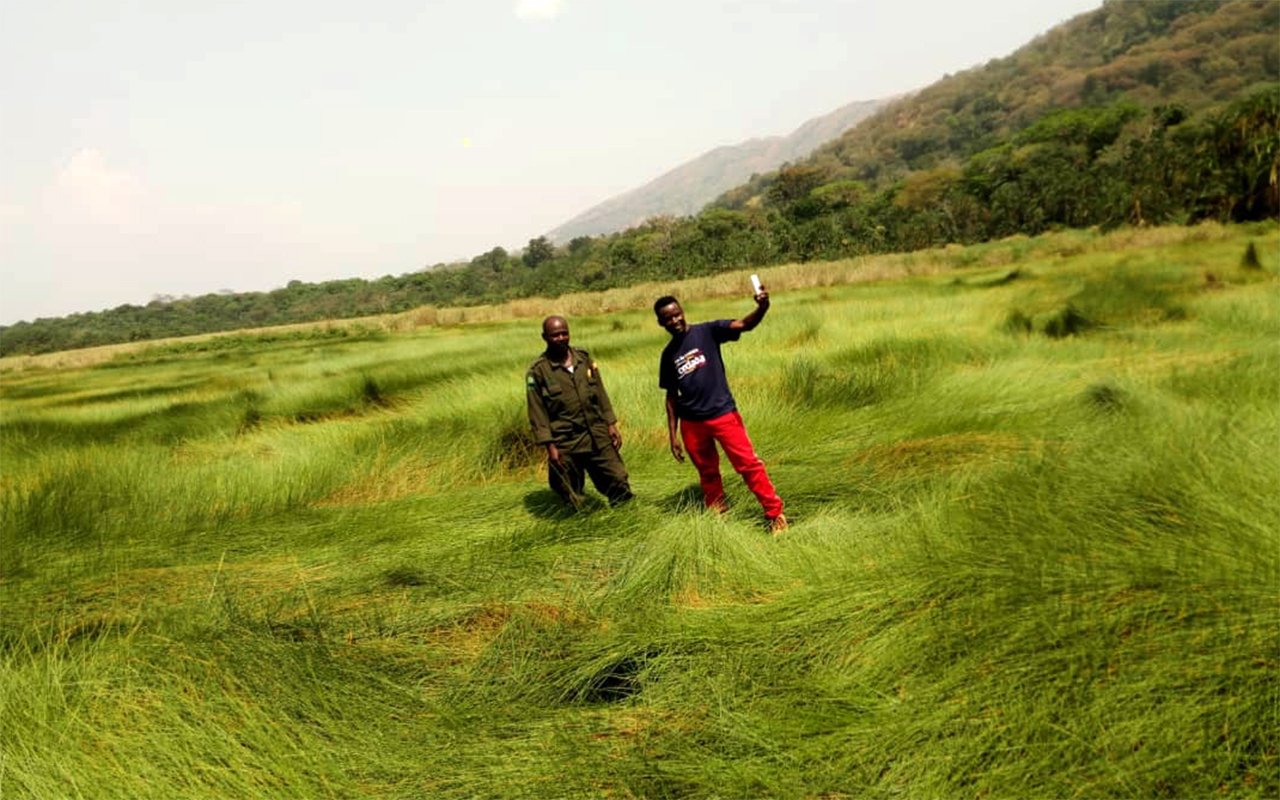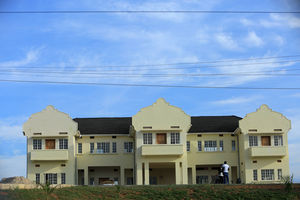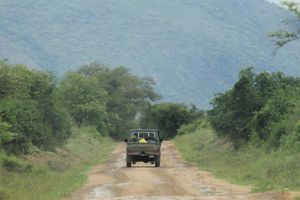
Now the road flattens, the view of Semliki Valley takes your breath away with her consistent green complexion and you suddenly feel safe again. PHOTO/TONY MUSHOBOROZI.
The journey to Semliki National Park starts in Fort Portal. Ironically, Fort Portal might also be the one obstacle that stands in the way to Semliki.
Consider this. This western Uganda city needs no introduction. It is a tourist hotspot loved by both foreign and local tourists equally. The idyllic beauty of the land, made even more appealing by the well-manicured tea plantations and untamed forests makes Fort Portal a stimulating town.
Fort Portal is home to some of the most scenic lake villages in the country, which explains why the place is inundated with top-of-the-range tourist lodges. If you want to see the beautiful Ugandan countryside, Fort Portal is where you go. The area is blessed with the kind of natural beauty that inspires unbridled patriotism, a passion for camping and a temptation for partying.
It is home to the famous Amabeere ga Nyina Mwiru, a geological formation that many Ugandans believe to hold spiritual powers. Its historical connection to the Bachwezi demi gods that ruled the ancient Bunyoro Kitara Kingdom makes this tourist site attractive to all sorts of tourists.
Finally, the beautiful townspeople are known for their friendliness and generosity. This tends to attract young people from Kampala and other towns to travel here just to have a great time. And when the party is over, most people never think of venturing further than Fort Portal. Most never seem to find out that just behind the imposing mountains west of Fort Portal town lies hidden a natural gem of cosmic proportions. That gem is Semliki National Park.
To get to Semliki, you ride westwards from Fort Portal town. Within about 20 minutes, the road enters the foothills of the Rwenzori Mountains and thus starts the long climb into the clouds above Fort Portal.
As you climb higher and higher, many of the hills that appeared insurmountable only a few minutes earlier drop below you and all signs of Fort Portal disappear. Now you are the bird.
The experience of riding at such a high altitude gets your spirit giddy. You wonder why you ever had a fear of heights because this is heaven. But, you must still ride higher and higher into the rugged mountains before you start to descend into Semliki.
One of the perks of riding on this road is how isolated it is. You barely see any vehicles on the road. One truck here, a passenger bus some five kilometres later, a tourist van far behind you. This makes it one of the most relaxing roads to ride a motorcycle on.
About midway into the 52-kilometre-journey, you arrive at a place with heart-stopping views of the mountain ranges. The place is so breathtaking, that someone decided to erect a viewing point. There is a parking area by the roadside enough for a few cars and a shed for people to sit and catch a breath before plunging into the valley.
Walk a few metres behind the shed and you reach the edge of a cliff. Here, the fresh breeze from people’s farms refreshes your soul and makes you fall in love with the outdoors once again. Across the valley, for as far as your eyes can see, hills contoured with terraces of crops present themselves. If you did not know better, you would think you were in Kisoro, which is further South on the same longitude.
From this point, you start the steep slope into the valley where Semliki lies. The road is so steep you barely swivel the accelerator for the entire 13-kilometre slope to the valley. It is the true definition of a winding road; one sharp corner after another, a proper zigzag. Forty-five-degree zingers.
As soon as you have emerged from the sharp corner than you brake for the speed bumps before entering an even sharper corner, all the while, nose-diving into the valley, surrounded by menacing cliffs on both sides of the road. Forget what I said earlier, it is not a relaxing ride after all.
This section is the reason a journey of just 52 kilometres from Fort Portal to Semuliki takes over two hours to cover by road. But the views of the mountains and the great green valley ahead, appearing and disappearing with every other corner make the ride so endurable. If it was not so isolated, it would be a tough road to navigate. Slowly by slowly, working the brakes carefully, you finally reach the valley. Now, you are in Bundibugyo District, the cocoa-growing hub of Uganda.
Now the road flattens, the view of Semliki Valley takes your breath away with her consistent green complexion and you suddenly feel safe again. Now you can have an actual relaxed ride. But you still have a considerable distance to cover before reaching the park gate at Sempaya gate.
As you cruise towards the destination, on your left stands a towering mountain range that shoots to the sky while on your right, a sprawling greenery that spans the entire floor of the valley.
The sun in Semuliki seems to shine different for some reason and I won’t even start to describe it. The tarmac road is almost pure white from lack of traffic.
Semuliki is so remote, it feels like a whole other country. The fact that it is completely cut off by the Rwenzori Mountains makes that feeling even more pronounced.
The park
The famed Sempaya hot springs in Semuliki national park are hidden away from highway farers by a crescent of trees. After crossing through the trees, you reach a beautiful mash that looks like God’s lawn; beautifully green and immaculately level. While it looks like recently mowed paspallum from afar, the grass is so tall it sways in the wind.
To ease movement, a wood platform has been built for tourists to walk on without getting bogged down by the marsh.
Birds
If you are lucky, you may be able to see the famous shoebill in this marsh.The shoebill is one of the many bird species endemic to Semliki. The park is home to 441 bird species, including the yellow-throated cuckoo, white-crested hornbill, red-ramped tinker bird, white-throated bleu swallow, etc.
The main attraction
The steam from the hot springs can be seen from afar, even when it is on the hot sunny day. When you finally reach the spot, you cannot help but marvel at the sheer unstoppable power of nature. It dawns on you that the earth is a breathing, living giant, only humble and gentle enough to allow us live on it.

The male and the female part of the hot springs are close to each other, perpetually keeping each other company. PHOTO/TONY MUSHOBOROZI.
The boiling water shoots out of the ground with so much force it warms up the air around the hot springs. Tourists with eggs and potatoes and matooke proceed to drop them in the water just so they can enjoy the privilege of eating food that nature itself has cooked.
The male and the female part of the hot springs are close to each other, perpetually keeping each other company. They both have different but distinct characteristics, with the female one being the more dramatic one, shooting boiling water several metres into the air, while the male one sits calmly nearby, not wanting to cause any trouble.
The hot springs hold a central spiritual position in the lives of the locals as they believe that their great-great-great-grand parents live in the hot springs.
Animals
Other than bird watching and the mesmerising hot springs, the tourists that come to Semliki come seeking animals as well. The park is home to 63 mammal species that include warthogs, monkeys, bush bucks, kobs, bush babies, buffalos, hippos, leopards and elephants to mention but a few. The park is the only one in East Africa to harbour the water chevrotain, a duiker that shares structural features with pig.
Semliki is also home to primates such as chimps, vervet monkeys, baboons, mangabeys, pottos and galagoes to mention a few.

Shoebill
Quick facts
Semliki National Park lies at the border with Congo just like Queen Elizabeth and Bwindi further south in the same Albertine rift valley. It measures about 220 square kilometres and was gazetted as a national park in 1993. It had been a forest reserve since 1932. The main attraction in the park remains the Sempaya hot springs.

